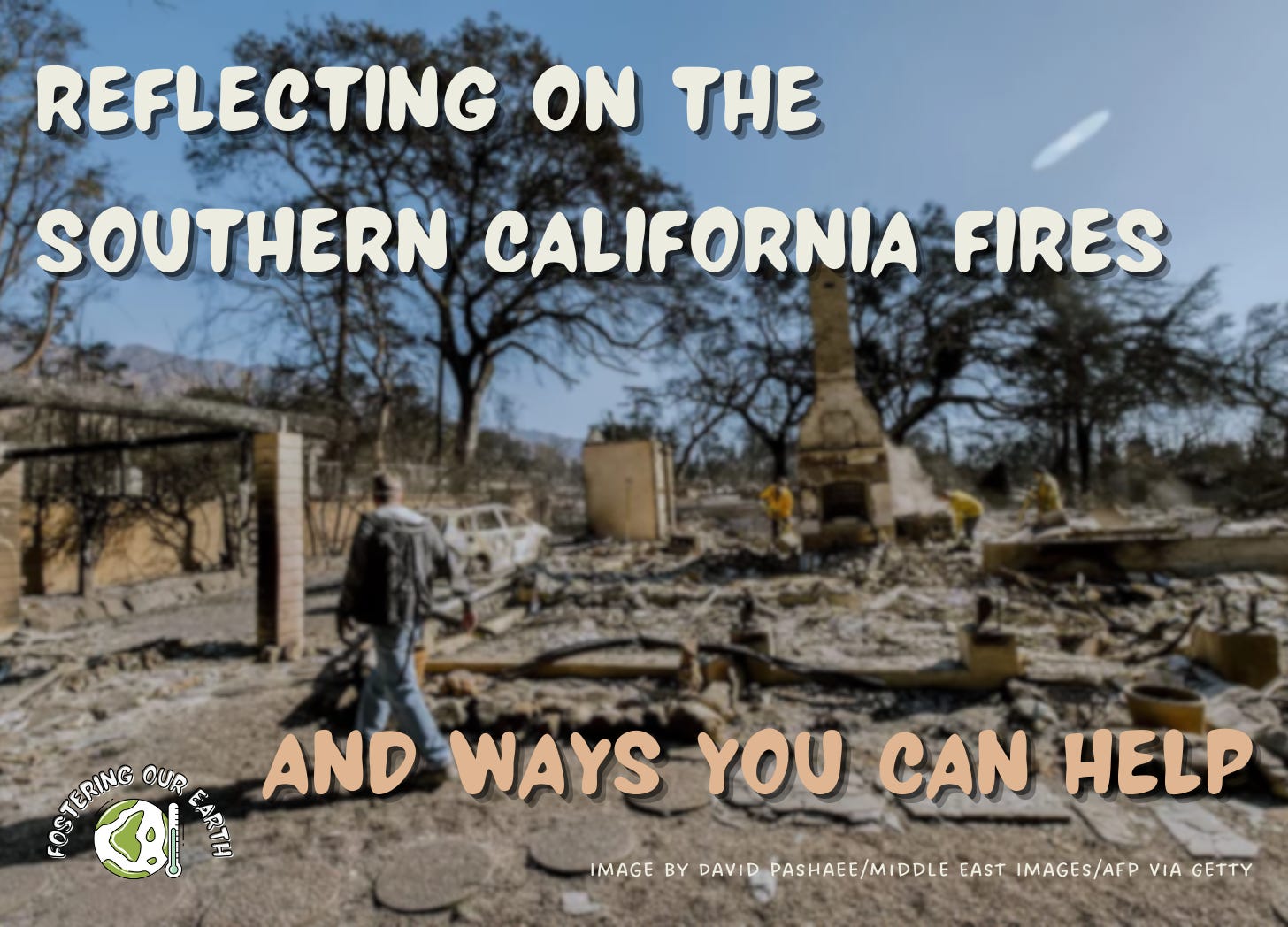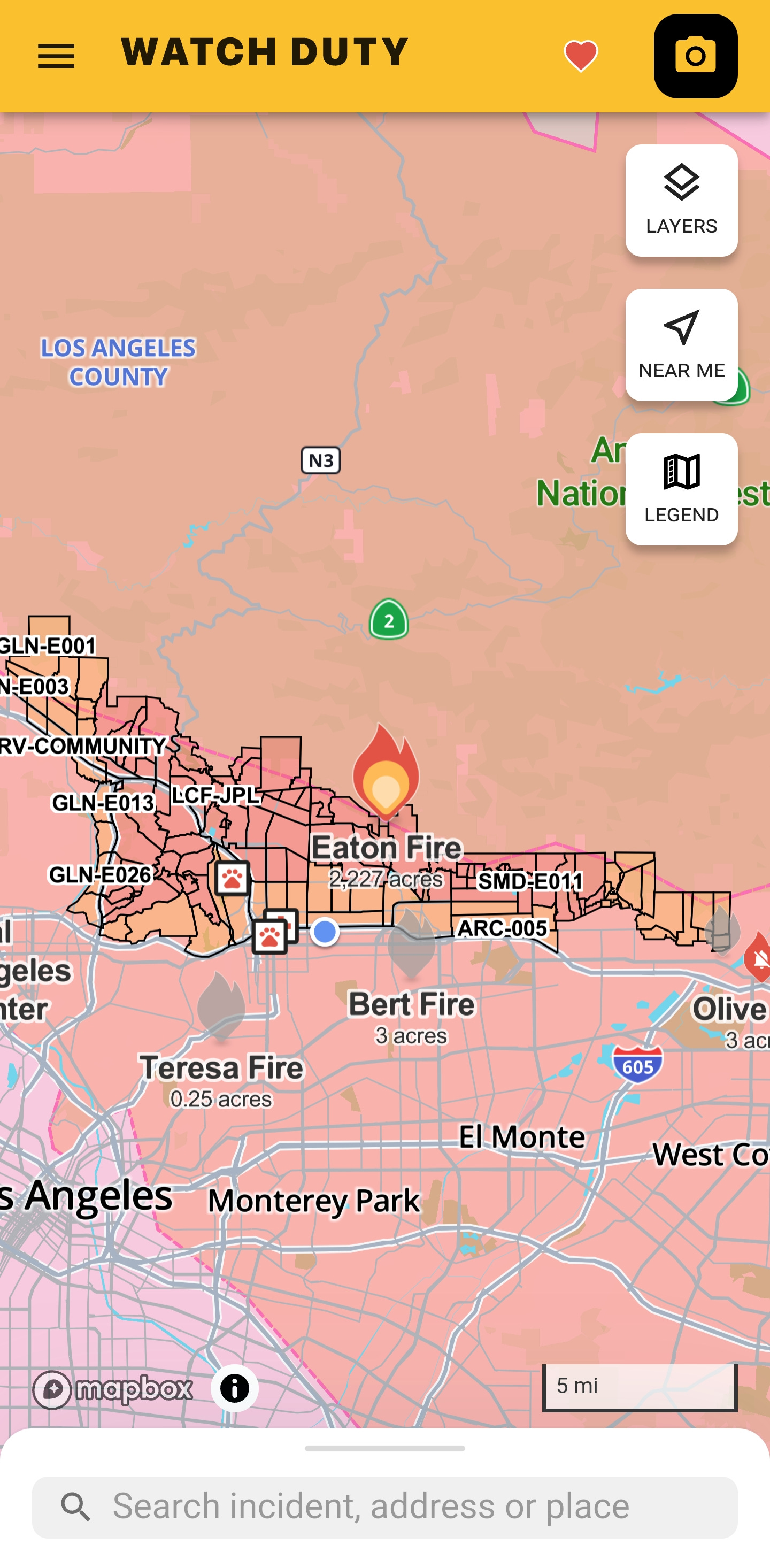Systemic Reflections on the SoCal Fires
Notes on climate displacement, resilience, and resources to learn more and help right now following the 2025 Palisades and Eaton Fires.
Hi future ancestors,
There's a quote that says "climate change will manifest as a series of disasters viewed through phones with footage that gets closer and closer to where you live until you're the one filming it". Late in 2024, we saw this in the unprecedented and devastating flooding in Asheville, NC. Now, early in 2025, we're seeing unprecedented wildfires across Southern California. Both incidents are personal to me — I spent my middle school years in Asheville, and I currently live in Pasadena, CA.
As I write this from Torrance, CA, where I've evacuated due to the Eaton Fire that broke out just a few miles north of my apartment, I am reflecting on the physical disorientation that came from this experience and some of the larger forces at play relating to these fires. The Eaton Fire has quickly spread to over 14,000 acres. At the same time, the Palisades Fire, Hurst Fire, and several other smaller fires have stretched resources thin across the county. Over 180,000 people have been forced to evacuate their homes. About ten people have lost their lives, and countless folks have lost their homes and businesses. As all of these are happening, we can firmly state that the climate crisis in front of us, but to really combat it we need to improve our infrastructure and land use decisions and ultimately continue building out community and systems of mutual aid.
One book I continually refer to below is Jake Bittle’s “The Great Displacement,” in which he discusses how climate change will push people out of their homes and the various existing political and economic systems that will contribute to this displacement and influence where people end up. I highly recommend folks go read it.
Understanding the factors behind the wildfires
While there are technical reasons for these fires, there are climate and political/economic systemic factors at play that impact these fires immediately and in the aftermath. On the climate side, the term "whiplash" helps us understand the conditions leading to the fires: years of California drought created dry conditions, and extremely heavy rainfall in 2022 and 2023 increased the growth of flammable vegetation. A record-breaking summer in 2024, followed by a dry fall and winter, turned this vegetation into kindling. Add to this the annual Santa Ana winds reaching over 80mph, and you have perfect conditions for devastating fires.
But as Jake Bittle points out in "The Great Displacement," while fires might ignite due to climate-induced conditions, the aftermath is "the product of an underfunded disaster relief system, a dire affordable housing shortage, and a broken insurance market."
These factors are painfully present in Los Angeles. The city council cut the fire department's funding by $17M while increasing the police budget by $126M. The county is already experiencing a housing crisis, with over 75,000 people in need of housing and many more facing rent burden. Due to fire risks, major insurance companies are abandoning the California market or canceling policies.
The deadly cycle connecting the housing crisis and wildfire risk
Over 9,000 structures (including homes, businesses, and schools) have been destroyed in these fires. Around 180,000 people were evacuated during the storms themselves. Where do these people go, especially with rents likely to skyrocket? Housing is a touchy topic in LA County, but it's crucial to understand its role in both causing wildfires and determining our resilience to them.
Housing policies that support sprawling development patterns can increase the risk of wildfires. LA's single-family zoning leads to sprawl, pushing development into wildfire-prone areas (the wildfire urban interface) and displacing natural landscapes. This sprawl isn't just about fire risk—it's about climate change itself. Single-family homes use more energy (subsequently producing more residential building emissions), and car-dependent development increases transportation emissions, creating a vicious cycle that makes future fires more likely.
One solution is building resilience through urban density. By relaxing zoning restrictions, we can create more efficient housing without putting people at risk of wildfires. This means transforming single-family zones into areas that can support multi-family homes, creating mixed-use, walkable communities that are also climate resilient. With calls for LA to improve its streamlining process to build more, we have an opportunity to not repeat the mistakes of the past and build better and smarter.
Jake Bittle asks what it means for us to have a right to shelter. To me, this isn’t just government enabling better land use practices in deciding where and the type of housing we build but also ensuring tenant protections. We’ve seen rent gouging already happening and it’s imperative that cities have measures in place to prevent this and guarantee shelter, equity, and even wealth building measures for its residents.
Community and mutual aid are key
Throughout this whole crisis, the only thing that has kept me oriented among the physical and information-based disorientation has been community. Community, through whatever means, has helped. Whether texts with my neighbors about how they’re responding or getting information to larger community groups, for me, through the Lombardy Run Club and Sunrise Movement LA, folks sharing their resources — which maps they're looking at, what to pack, which roads are closed, photos, words of encouragement, and now that we’re past the initial response, sharing supplies and coordinating volunteer opportunities and guides. Community is one strong pillar we must continue to develop so we can rely on it when times get tough.
What You Can Do
Timothy Snyder says in "On Tyranny" that we should contribute to good causes. By making the "free choice to support causes that help civil society and others to do good," we can actively improve the world around us. If you're wondering how to help, here are some direct ways:
Support Displaced Families
It’s been heartbreaking on my end to see people I know, and many I don’t, lose their homes, communities, and everything in-between. Below are links to spreadsheets with GoFundMe links to donate to these families. I know these are big asks but these really make a difference for these families.
External Donations
Below are links to organizations doing work to support families and workers impacted by the fires. Again, if you’re able, these are great causes to donate to.
https://www.gofundme.com/f/cash-aid-for-outdoor-workers-impacted-by-la-county-wildfires
https://www.cafirefoundation.org/what-we-do/for-communities/disaster-relief
Donate to Watch Duty, the app that kept thousands of others and me informed!
Here’s a screenshot of the app during the emergency showing the evacuation zones and live updates.
Further Reading
If you’re interested in reading and want to learn more, here are a few articles I’ve been reading, and books I recommend.
"From Gaza to California: the flames that connect us all" (Mondoweiss) - Explores how "the fires burning in Palestine and Los Angeles today are symptoms of the same disease: a system that values conquest over conservation, profit over people, and expansion over existence."
"The Last Wildfire-Fighting Camp for Incarcerated Teens in California" (Teen Vogue) - Examines the labor exploitation of incarcerated youth in firefighting
The California wildfires could be leaving deeper inequality in their wake | AP News
"The Great Displacement" by Jake Bittle
"Parable of the Sower" by Octavia Butler
As Bittle warns us, "by the end of the century, climate change will displace more people in the United States than moved during the Great Migration." The fires we're experiencing now are just the beginning. How we respond – through policy, through community action, through mutual aid – will determine our collective future.
Thanks for reading,
Awoe ✌🏾



